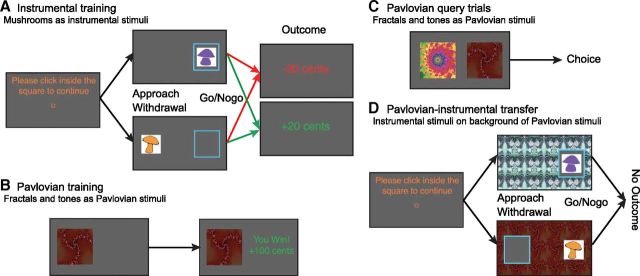Figure 1.
A, Instrumental training. To center the cursor, participants clicked in a central square. The experiment consisted of a block with exclusively instrumental approach trials (n = 120) and a block with exclusively withdrawal trials (n = 120). In approach trials (top), participants chose whether to move the cursor toward the mushroom and click inside the blue frame onto the mushroom (go), or do nothing (nogo). In withdrawal trials, they instead moved the cursor away from the mushroom and clicked in the empty blue frame (go) or did nothing (nogo). Outcomes were presented immediately after go actions, or after 1.5 s. Per block, there were three “good” and three “bad” instrumental stimuli. Participants played each block ones per testing day. Instrumental stimuli were different for both blocks, but the same for both days. B, Pavlovian conditioning. Participants passively viewed stimuli and heard auditory tones, followed by wins and losses. There were five fractal/tone combinations. Each combination was displayed 12 times in the first block and another six times in the second block. C, On Pavlovian query trials, participants chose between two Pavlovian stimuli. No outcomes were presented, but they were counted and added to the total presented at the end of the experiment. Query trials were administered after every five Pavlovian conditioning trials. D, PIT participants responded to the instrumental stimuli trained during the instrumental training stage, with Pavlovian stimuli tiling the background. No outcomes were presented, but participants were instructed that their choices counted toward the final total. No explicit instructions about the contribution of Pavlovian stimuli towards the final total were given.

